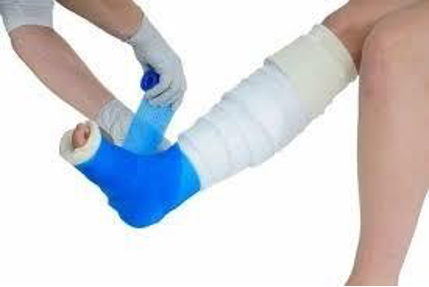Patient and parent education for the child who has a synthetic cast should include which of the following?
Applying a heating pad to the cast if the child has swelling in the affected extremity
Covering the cast with plastic and waterproof tape to keep it dry while bathing or showering
Splitting the cast if the child complains of numbness or pain
Wrapping the outer surface of the cast with an Ace bandage
The Correct Answer is B
The primary concern when it comes to a synthetic cast is to keep it dry during bathing or showering. Moisture can weaken the cast material and lead to skin irritation or infection. Therefore, covering the cast with plastic and waterproof tape helps to protect it from getting wet.
Applying a heating pad to the cast if the child has swelling in the affected extremity in (Option A) is incorrect because applying a heating pad to the cast can increase the risk of burns and is not recommended. If the child has swelling in the affected extremity, it is important to elevate the limb and follow any specific instructions provided by the healthcare provider.
Splitting the cast if the child complains of numbness or pain in (Option C) is also incorrect. Splitting the cast, or attempting to modify or adjust it, should not be done without medical supervision. If the child complains of numbness or pain, it is important to notify the healthcare provider for further evaluation and appropriate management.
|
Wrapping the outer surface of the cast with an Ace bandage in (Option D) is incorrect as well. Wrapping the outer surface of the cast with an Ace bandage or any additional material is not recommended unless specifically instructed by the healthcare provider. It can affect the fit of the cast, alter the healing process, and potentially cause complications |

Nursing Test Bank
Naxlex Comprehensive Predictor Exams
Related Questions
Correct Answer is A
Explanation
A change in status that should alert the nurse to increased intracranial pressure (ICP) in a child with a head injury is confusion and altered mental status. As intracranial pressure increases, it can affect brain function and lead to neurological changes, including confusion, disorientation, irritability, decreased level of consciousness, or other alterations in mental status. These changes indicate that the brain is being compressed and compromised, and immediate intervention is required.
Option B, increased diastolic pressure with narrowing pulse pressure in (option B) is incorrect because it, can be a sign of increased ICP, but it is not specific to head injuries and can be influenced by other factors such as pain, anxiety, or systemic conditions. It is important to consider the overall hemodynamic status of the child and assess for additional signs and symptoms of increased ICP.
irregular, rapid heart rate in (option C), can be a sign of increased ICP, but it is not specific to head injuries and can be influenced by other factors such as pain, anxiety, or other medical conditions. Assessment of heart rate should be considered along with other signs and symptoms of increased ICP.
rapid, shallow breathing, in (option D) can be a sign of increased ICP, but it is not specific to head injuries and can be influenced by other factors such as pain, anxiety, or respiratory conditions. Respiratory assessment should be considered along with other signs and symptoms of increased ICP.
Correct Answer is A
Explanation
In a teaching plan for the mother of an 11-year-old boy with ulcerative colitis, the nurse should stress the importance of coping with stress and avoiding triggers. Ulcerative colitis is a chronic inflammatory bowel disease that can be influenced by various factors, including stress and triggers. Helping the child and the family develop effective stress management strategies and identifying and avoiding triggers can help in reducing the frequency and severity of ulcerative colitis flare-ups.
preventing the spread of illness to others in (option B) is incorrect because it, is not the primary focus of teaching for ulcerative colitis. Ulcerative colitis is not an infectious condition that can be spread to others.
, nutritional guidance and supportive intake of sodas in (option C) is incorrect because it, is an important aspect of managing ulcerative colitis. However, it should be addressed in conjunction with a comprehensive nutritional plan that considers the individual needs and tolerances of the child. The mention of supportive intake of sodas may not be appropriate, as carbonated beverages can potentially aggravate symptoms in some individuals with ulcerative colitis.
teaching daily use of enemas in (option D) is incorrect because it, is not typically a part of routine care for ulcerative colitis in children. The use of enemas may be considered in specific situations or as part of an individualized treatment plan under the guidance of healthcare providers, but it is not a general teaching point for all children with ulcerative colitis.
Whether you are a student looking to ace your exams or a practicing nurse seeking to enhance your expertise , our nursing education contents will empower you with the confidence and competence to make a difference in the lives of patients and become a respected leader in the healthcare field.
Visit Naxlex, invest in your future and unlock endless possibilities with our unparalleled nursing education contents today
Report Wrong Answer on the Current Question
Do you disagree with the answer? If yes, what is your expected answer? Explain.
Kindly be descriptive with the issue you are facing.
